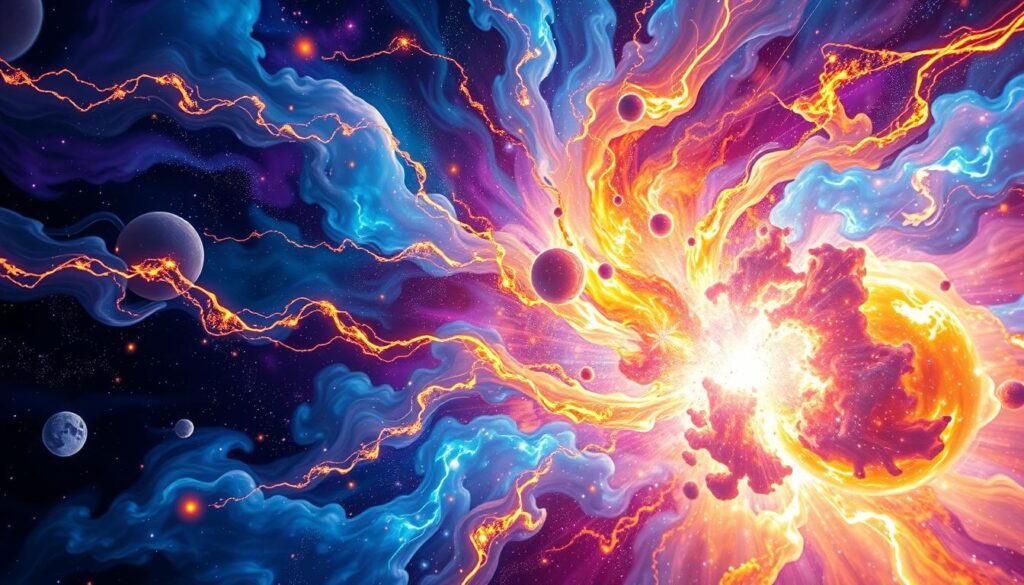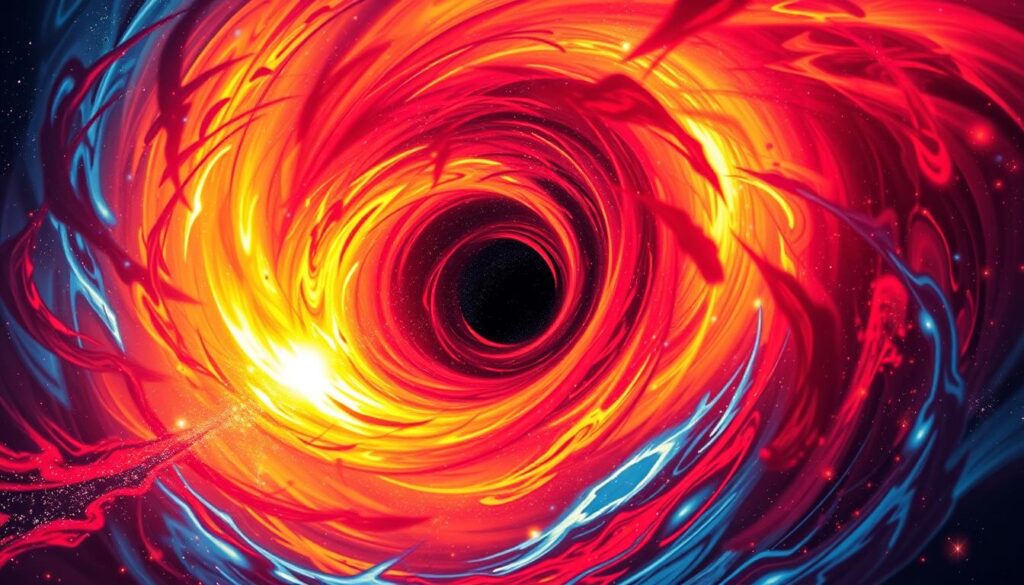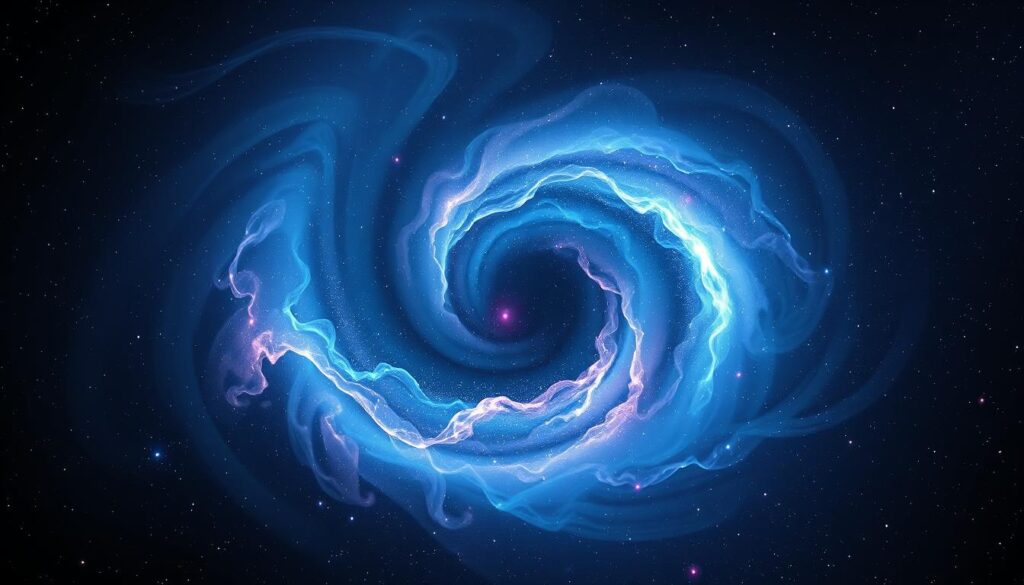
A vibrant explosion of cosmic colors and swirling gases, depicting the moment of the Big Bang; bright hues of blue, purple, and gold radiating outwards, with shimmering stars forming amidst the chaotic energy, encapsulating the birth of the universe in a dynamic, ethereal scene.
The Big Bang theory says the universe started from a single point in space. This huge explosion happened about 13.7 billion years ago. It’s the main idea for how the universe began, backed by space expansion and background radiation. Belgian priest Georges Lemaître came up with the Big Bang idea in the 1920s.
Key Takeaways
- The Big Bang theory suggests the universe began from a single, extremely hot, and dense point in space around 13.7 billion years ago.
- This theory is supported by the observed expansion of the universe and the detection of the cosmic microwave background radiation.
- Belgian priest Georges Lemaître first suggested the Big Bang theory in the 1920s.
- The Big Bang theory is the most widely accepted explanation for the origin of the universe.
- Understanding the early universe and the Big Bang event is a key focus of modern cosmology and astrophysics.
What is the Big Bang Theory?
The big bang theory explains how our universe began. It says the cosmos was once very hot and dense. Now, it’s expanding and cooling down.
The Big Bang Theory is the leading explanation for the origin and evolution of the universe. According to this theory, the universe began as an incredibly hot and dense point, or singularity, approximately 13.8 billion years ago. This singularity expanded rapidly in a process known as cosmic inflation, leading to the formation of matter and the universe as we know it.
As the universe expanded, it cooled, allowing particles to combine and form atoms. Over time, these atoms coalesced to form stars and galaxies. The theory explains the observed large-scale structure of the cosmos, including the distribution of galaxies and the cosmic microwave background radiation, which is a faint glow left over from the early hot phase of the universe.
The Big Bang Theory also accounts for the observed expansion of the universe, a phenomenon discovered by Edwin Hubble in the 1920s. Hubble observed that galaxies are moving away from us, suggesting that the universe is expanding.
Overall, the Big Bang Theory provides a comprehensive framework for understanding the early development and current state of the universe.
The Cosmic Expansion
In the 1920s, Edwin Hubble found something important. He saw that other galaxies are moving away from us. The faster they move, the farther they are.
This is called Hubble’s law. It shows the universe is still growing.
Evidence Supporting the Big Bang
The cosmic microwave background radiation (CMB) is another key piece of evidence. It was first seen in 1964. This faint glow is thought to be from the early, extremely hot universe.
The CMB and the redshift of distant galaxies also support the big bang theory. They show the universe started hot and has been cooling and expanding ever since.
Several key pieces of evidence support the Big Bang Theory, making it the most widely accepted model for the origin and evolution of the universe. Here are the main lines of evidence:
- Cosmic Microwave Background Radiation (CMB):
- Discovery: In 1965, Arno Penzias and Robert Wilson discovered a faint, uniform radiation coming from all directions in space, which is now known as the cosmic microwave background (CMB).
- Significance: The CMB is a remnant of the heat from the early universe, a “snapshot” of the universe when it was about 380,000 years old, shortly after the Big Bang. Its uniformity and slight fluctuations match predictions from the Big Bang Theory.
- Expansion of the Universe:
- Observations: Edwin Hubble’s observations in the 1920s showed that galaxies are moving away from us, with their speeds proportional to their distances. This is known as Hubble’s Law.
- Implication: The observation of an expanding universe implies that the universe was once much smaller and denser, supporting the idea of an initial Big Bang.
- Abundance of Light Elements:
- Predictions: The Big Bang Nucleosynthesis theory predicts the amounts of light elements (such as hydrogen, helium, and lithium) produced in the first few minutes of the universe.
- Observations: Observations match these predictions quite well, particularly the abundance of helium and deuterium in the oldest stars and in the interstellar medium.
- Large-Scale Structure of the Universe:
- Formation: The distribution and clustering of galaxies and the large-scale structure of the universe can be explained by the growth of initial quantum fluctuations through cosmic inflation and gravitational collapse.
- Models: Computational models based on the Big Bang Theory successfully reproduce the observed large-scale structure.
- Galaxy Formation and Evolution:
- Observation: The distribution of galaxies and their redshifts (indicating how much the universe has expanded since they emitted their light) are consistent with predictions from the Big Bang model.
- Evolution: Observations of distant galaxies show that the universe was denser and more chaotic in the past, supporting the model of an evolving universe that started from a hot, dense state.
- General Relativity:
- Theory: Einstein’s theory of general relativity provides the framework for understanding the dynamics of an expanding universe.
- Predictions: Solutions to Einstein’s equations (such as the Friedmann equations) predict the expansion of the universe, which aligns with the observed expansion and the Big Bang model.
These lines of evidence collectively support the Big Bang Theory and help us understand the universe’s history, from its earliest moments to its current state.
“The big bang theory is the prevailing cosmological model for the observable universe from the earliest known periods through its subsequent large-scale evolution.”
The Big Bang: A Moment of Creation

A swirling vortex of vibrant colors representing the intense energy of the Big Bang singularity, fiery reds, brilliant yellows, and deep blues radiating outward, with abstract cosmic elements like stars and galaxies forming in the background, creating a sense of explosive creation and vast infinite space.
The Big Bang theory says the whole universe started from a super-hot, dense point called a singularity. It claims the universe began with a huge explosion about 13.7 billion years ago. This idea is backed by the universe’s expansion and background radiation.
Right after the Big Bang, the universe expanded and cooled fast. This led to the creation of the first particles and early structures. This early expansion, known as the inflationary universe, set the stage for what we see today.
Belgian priest Georges Lemaître first talked about the Big Bang in the 1920s. He called the universe’s start a “primeval atom.” Since then, lots of science has supported this idea, making it the top theory for the universe’s beginning.
The Big Bang theory says the universe began in a burst of creation. From a single point, the universe expanded and cooled. This led to the galaxies, stars, and other things we see today.
Exploring the Early Universe

“An ethereal representation of the cosmic microwave background, showcasing a swirling tapestry of vibrant colors and intricate patterns, symbolizing the afterglow of the Big Bang, with soft gradients of blues, purples, and whites, scattered with tiny glowing specks reminiscent of ancient starlight, all set against a deep black cosmic void.”
The cosmic microwave background (CMB) radiation is key to understanding the universe’s early days. This faint glow, found in 1964, is thought to be the universe’s leftover heat from the Big Bang. The Big Bang happened about 13.7 billion years ago.
Cosmic Microwave Background Radiation
The cosmic microwave background radiation is vital for the Big Bang theory. It helps us understand how the universe expanded and evolved in its early days. This radiation fills the whole universe, giving us a peek into the universe’s first few hundred thousand years.
The discovery of the CMB was a major breakthrough in cosmology. It proved the Big Bang theory and debunked other theories like the Steady State theory. The CMB’s uniformity and thermal spectrum match the Big Bang model, making it a cornerstone of our universe’s history.
By looking at the CMB’s small changes, scientists learn a lot about the early universe. They find out about the first stars and galaxies, dark matter and dark energy, and the universe’s shape. This research keeps improving our understanding of the universe and our place in it.
Conclusion
The Big Bang theory is now the top idea for how the universe started and grew. Belgian priest Georges Lemaître first thought of it in the 1920s. He believed the universe began from a single, incredibly dense point that exploded about 13.7 billion years ago.
This theory can explain many things we see in the universe. For example, it explains the cosmic microwave background radiation and how space is expanding. These facts help make the Big Bang theory the main idea in science about the universe.
Even though there are still things we don’t know, the Big Bang theory helps us understand a lot. Scientists keep studying to learn more about the universe’s start and how it’s still growing. The Big Bang theory is a key tool for them to explore the universe’s origins and future.
Scientists are still trying to understand more about the Big Bang and the early universe. They are looking into dark matter and dark energy, if there are other universes, and what will happen to our universe in the end. As we learn more, the Big Bang theory will keep guiding us in our journey to understand the universe and its amazing beginnings.
Important Point
| NO. | Important Points |
| 1. | About Us |
| 2. | Contact Us |
| 3. | Disclaimer |
| 4. | Privacy Policy |
FAQs of Big bang
What is the Big Bang theory?
The Big Bang theory says the universe started in a super-hot, dense state. It has been growing and cooling down since then. This theory is widely accepted, backed by background radiation and space expansion.
What evidence supports the Big Bang theory?
The universe’s expansion, noticed by Edwin Hubble, supports the Big Bang. Also, the cosmic microwave background radiation, a faint glow from the early universe, backs the theory.
How did the universe originate according to the Big Bang theory?
The Big Bang theory says the universe came from a super-hot, dense point called a singularity. Right after the Big Bang, the universe expanded and cooled fast. This led to the creation of the first particles and the universe’s early structures.
What is the cosmic microwave background radiation?
The cosmic microwave background (CMB) radiation is a faint glow across the universe. It gives insights into the Big Bang’s early stages. Discovered in 1964, it’s thought to be the leftover heat from the Big Bang, crucial for understanding the universe’s evolution.
What is the current status of the Big Bang theory?
The Big Bang theory is the main idea for how the universe began and evolved. It’s not perfect, but it explains many observations and makes accurate predictions. This has made it the top theory for the universe’s explosive start and ongoing growth.
What are the additional keywords related to the Big Bang theory?
More keywords for the Big Bang theory include: cosmic expansion, singularity, inflationary universe, redshift, Hubble’s law, and cosmology.

Pingback: Exploring Binary Star Systems: Cosmic Dance of Stars 1